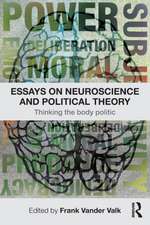Biochemistry and Physiology of Visual Pigments: Symposium Held at Institut für Tierphysiologie, Ruhr-Universität Bochum/W. Germany, August 27–30, 1972
Editat de Helmut Langeren Limba Engleză Paperback – 18 aug 2012
Preț: 647.27 lei
Preț vechi: 761.49 lei
-15% Nou
Puncte Express: 971
Preț estimativ în valută:
123.87€ • 128.85$ • 102.26£
123.87€ • 128.85$ • 102.26£
Carte tipărită la comandă
Livrare economică 14-28 aprilie
Preluare comenzi: 021 569.72.76
Specificații
ISBN-13: 9783642857713
ISBN-10: 364285771X
Pagini: 384
Ilustrații: XIII, 368 p.
Dimensiuni: 170 x 244 x 20 mm
Greutate: 0.61 kg
Ediția:Softcover reprint of the original 1st ed. 1973
Editura: Springer Berlin, Heidelberg
Colecția Springer
Locul publicării:Berlin, Heidelberg, Germany
ISBN-10: 364285771X
Pagini: 384
Ilustrații: XIII, 368 p.
Dimensiuni: 170 x 244 x 20 mm
Greutate: 0.61 kg
Ediția:Softcover reprint of the original 1st ed. 1973
Editura: Springer Berlin, Heidelberg
Colecția Springer
Locul publicării:Berlin, Heidelberg, Germany
Public țintă
ResearchDescriere
This book is a report of a four-day Symposium on the Biochemistry and Physiology of Visual Pigments, which took place immediately after the VIth International Congress on Photobiology, held in Bochum, Federal Republic of Germany, in August 1972. This meeting, which brought together about 50 investigators of various aspects of the visual process, was devoted to the visual cells of both vertebrates and invertebrates. Whereas the International Symposium on the Biochemistry of the Retina, held at Nij megen, The Netherlands, in 1968, had concentrated on vertebrate photoreceptors, this Symposium dealt with invertebrate photoreceptors as well, so that workers in each field could become acquainted with recent progress in the other area. The papers presented at the Symposium were divided into six main topics, to each of which a half-day session was devoted. The six parts of this book, following the intro ductory lecture, essentially correspond to these sessions. In addition to the invited con tributions, the volume contains a number of short communications by other partici pants and two contributions by invited participants, who were unable to attend. The volume closes, as did the Symposium, with a General Discussion, prepared and moderated by S. L. BONTING, in which an attempt was made to integrate various new findings, and to reconcile certain points of disagreement.
Cuprins
Introductory Lecture.- Visual Pigments and Photoreceptor Physiology.- I. Pigment Structure and Chemical Properties.- Theory of Retinal and Related Molecules.- Conformations of 11-cis Retinal.- The Binding Site of Retinaldehyde in Native Rhodopsin.- Chromophore Migration after Illumination of Rhodopsin.- II. Photolysis and Intermediates of the Pigments.- The Kinetics of Early Intermediate Processes in the Photolysis of Visual Pigments.- Photoselection and Linear Dichroism of Retinal Isomers and Visual Pigments.- Studies on Intermediates of Visual Pigments by Absorption Spectra at Liquid Helium Temperature and Circular Dichroism at Low Temperatures.- Interconversion of Metarhodopsins.- Temperature Dependence of Slow Thermal Reactions during the Bleaching of Rhodopsin in the Frog Retina.- Metarhodopsin III.- The Effect of Urea upon the Photosensitivity of Bovine Rhodopsin.- III. Regeneration of the Pigments.- Interrelations of Visual Pigments and “Vitamins A” in Fish and Amphibia.- A Catalytic Role of Dihydroriboflavin in the Geometrical Isomerization of all-trans Retinal.- Active Site and Enzymological Studies on the Components of the Visual Cycle.- Formation of Isorhodopsin from Photolyzed Rhodopsin in Darkness.- Behavior of Rhodopsin and Metarhodopsin in Isolated Rhabdoms of Crabs and Lobster.- Photoregeneration and Sensitivity Control of Photoreceptors of Invertebrates.- The Photopigments in an Insect Retina.- Rhodopsin Processes and the Function of the Pupil Mechanism in Flies.- Biochemical Properties of Retinochrome.- IV. Excitation and Adaptation of Photoreceptor Cells.- Energy in Vertebrate Photoreceptor Function.- Rod Dark-Adaptation and Visual Pigment Photoproducts.- Long-Lived Photoproducts in the Retinae of the Frog and the Crucian Carp.- Adaptation Properties of Intracellularly Recorded Gekko Photoreceptor Potentials.- Receptor Adaptation and Receptor Interactions: Some Results of Intracellular Recordings (Preliminary Note).- Excitation and Adaptation in the Cephalopod Retina: An Equivalent Circuit Model.- V. Ionic Aspects of Excitation and Regeneration.- Experiments on the Ionic Mechanism of the Receptor Potential of Limulus and Crayfish Photoreceptor.- Control of the Dark Current in Vertebrate Rods and Cones.- Spatial Origin of the Fast Photovoltage in Retinal Rods.- Photovoltages and Dark Voltage Gradients Across Receptor Layer of Dark-Adapted Rat Retina.- In vitro Physiology of Frog Photoreceptor Membranes.- The Internal Transmitter Model for Visual Excitation: Some Quantitative Implications.- VI. Enzymology and Molecular Architecture of the Light Sensitive Membrane.- Chemo-Surgical Studies on Outer Segments.- Ultrastructure of the Photoreceptors of the Bovine Retina.- Microspectrophotometry of Visual Receptors.- Dichroism in Rods during Bleaching.- Octopus Rhodopsin in situ: Microphotometric Measurements of Orientational and Spectral Changes.- Studies on the Assembly of Rod Outer Segment Disc Membranes.- Enzyme and Phospholipid Patterns in the Compound Eye of Insects.- Cyclic AMP and Photoreceptor Function.- The Effects of Cyclic Nucleotide Phosphodiesterase Inhibitors on the Frog Rod Receptor Potential.- General Discussion. Moderator and Reporter.- Index of Contributors.












